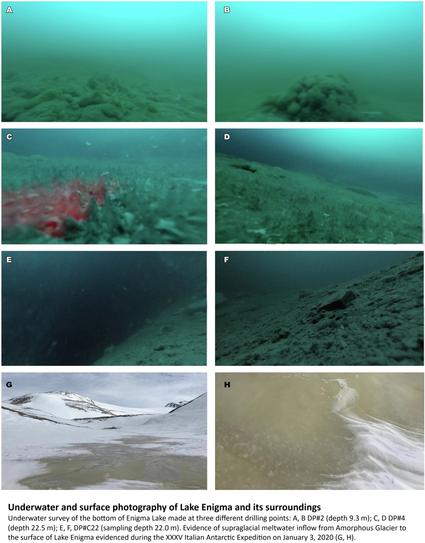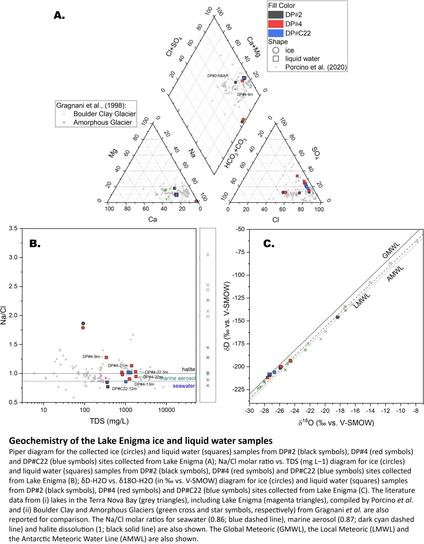
Scientists peered into a secret Antarctic lake hidden beneath the ice — and uncovered a never-before-seen ecosystem
Scientists investigating the frozen Lake Enigma in Antarctica discovered an ecosystem teeming with strange microbial communities.
New #deadwood paper is out! Unusual metabolic traits were identified in bacterial taxa Steroidobacteraceae (nitrogen fixation) and #Patescibacteria (hemicellulose and chitin recycling). These features are useful in decomposing deadwood.
https://doi.org/10.1186/s40793-024-00639-5

Long-read sequencing sheds light on key bacteria contributing to deadwood decomposition processes - Environmental Microbiome
Background Deadwood decomposition is an essential ecological process in forest ecosystems, playing a key role in nutrient cycling and carbon sequestration by enriching soils with organic matter. This process is driven by diverse microbial communities encompassing specialized functions in breaking down organic matter, but the specific roles of individual microorganisms in this process are still not fully understood. Results Here, we characterized the deadwood microbiome in a natural mixed temperate forest in Central Europe using PacBio HiFi long-read sequencing and a genome-resolved transcriptomics approach in order to uncover key microbial contributors to wood decomposition. We obtained high quality assemblies, which allowed attribution of complex microbial functions such as nitrogen fixation to individual microbial taxa and enabled the recovery of metagenome-assembled genomes (MAGs) from both abundant and rare deadwood bacteria. We successfully assembled 69 MAGs (including 14 high-quality and 7 single-contig genomes) from 4 samples, representing most of the abundant bacterial phyla in deadwood. The MAGs exhibited a rich diversity of carbohydrate-active enzymes (CAZymes), with Myxococcota encoding the highest number of CAZymes and the full complement of enzymes required for cellulose decomposition. For the first time we observed active nitrogen fixation by Steroidobacteraceae, as well as hemicellulose degradation and chitin recycling by Patescibacteria. Furthermore, PacBio HiFi sequencing identified over 1000 biosynthetic gene clusters, highlighting a vast potential for secondary metabolite production in deadwood, particularly in Pseudomonadota and Myxococcota. Conclusions PacBio HiFi long-read sequencing offers comprehensive insights into deadwood decomposition processes by advancing the identification of functional features involving multiple genes. It represents a robust tool for unraveling novel microbial genomes in complex ecosystems and allows the identification of key microorganisms contributing to deadwood decomposition.
Unlocking the Secrets of Microbial Dark Matter: The Enigmatic World of Patescibacteria
Scientists uncover the genes essential for the unusual lifestyle of minuscule bacteria that live on the surface of larger bacteria.
Patescibacteria are a mysterious group of minute microbes with elusive survival methods. While scientists can only cultivate a handful of these types, they are part of a diverse family found in many environments.
https://scitechdaily.com/unlocking-the-secrets-of-microbial-dark-matter-the-enigmatic-world-of-patescibacteria/ #Microbial #DarkMatter #Patescibacteria #bacteria #genetics
Unlocking the Secrets of Microbial Dark Matter: The Enigmatic World of Patescibacteria
Scientists uncover the genes essential for the unusual lifestyle of minuscule bacteria that live on the surface of larger bacteria. Patescibacteria are a mysterious group of minute microbes with elusive survival methods. While scientists can only cultivate a handful of these types, they are part of

Genetic tools probe microbial dark matter
Patescibacteria are a group of puzzling, tiny microbes whose manner of staying alive has been difficult to fathom. Scientists can cultivate only a few types, yet these bacteria are a diverse group found in many environments.
Genetic manipulations were used to obtain new information on so-called microbial dark matter
An article published in the journal 'Cell' reports the results of the use of genetic manipulation to study the behavior of some bacteria belonging to a large...



